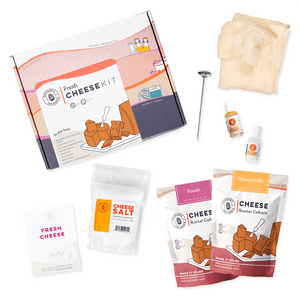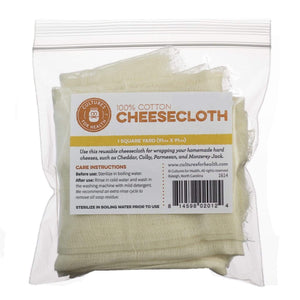
Manchego is an easy and versatile cheese to make, because it is rich and flavorful whether you age it for a week or a month. You can make it with cow milk, goat milk, or a combination of the two! If you use only cow milk, you may want to consider adding lipase for a stronger flavor. Manchego melts beautifully and is wonderful on top of pasta or vegetables.
20 minutes
180 minutes
4
INGREDIENTS AND EQUIPMENT AVAILABLE AT CULTURES FOR HEALTH
Fresh Cheese Making Kit

Fresh Cheese Making Kit
$45.99
Our most comprehensive choice, the Fresh Cheese Kit contains two starter cultures and supplies to make five different varieties of soft cheese - feta, cottage cheese, cream cheese, fromage blanc, and traditional quark. Kit contains a Mesophilic Cheese Culture, a Fresh Cheese Culture, calcium chloride, vegetable rennet, cheese salt, butter muslin, a thermometer, and an instruction and recipe card.
Packaging and Equipment in the kit may appear different than pictured.
Cheesecloth

Cheesecloth
$7.99
A looser weave than our butter muslin, this 100% cotton cheesecloth is great for wrapping cheeses and draining whey from all sorts of cultured foods.
EQUIPMENT
- Large pot
- Thermometer
- Long knife (does not need to be sharp)
- Wire whisk
- 2 pieces cheesecloth
- Cheese press
INGREDIENTS:
- 2 gallons fresh cow milk, goat milk, or both
- 1/4 tsp. lipase powder, dissolved in 1/4 cup cool water and allowed to set for 20 minutes (optional)
-
Mesophilic culture (choose one):
- 1 packet direct-set mesophilic culture
- 1/8 tsp. bulk mesophilic culture
-
Thermophilic culture (choose one):
- 1 packet direct-set thermophilic culture
- 1/8 tsp. bulk thermophilic culture
-
Rennet (choose one):
- 1/2 tsp. liquid animal rennet
- 1/4 tsp. double-strength liquid vegetable rennet, dissolved in 1/2 cup cool water
- 1/4 tablet vegetable rennet, dissolved in 1/2 cup cool water
- 2 Lbs. sea salt
INSTRUCTIONS:
- Heat the milk to 86°F. Add both the mesophilic and the thermophilic cultures and stir well using up-and-down motions. Cover and allow to ferment for 1 hour.
- Add the lipase and stir well. Then stir to homogenize the milk, and slowly fold in the diluted rennet, using an up-and-down motion.
- Allow the cheese to set for 30 to 45 minutes, or until the whey begins to separate from the curd. You should see a layer of mostly clear whey floating on top of the curd, and the curd should be pulling away from the sides of your pot. If you use lipase, this may take a little longer.
- Using a long knife, cut the curds into 1/2-inch cubes and allow to set for 5 minutes. Do not stir.
- Stir the curd with the whisk for 30 minutes, slicing it into small pieces. The curds should all be roughly the same size.
- Over the next 30 minutes, slowly heat the curds to 100°F, stirring frequently. As you stir, the curds will shrink. Once the curds are at 100°F, turn off the heat and allow to set for 5 minutes.
- Pour the curds into a press lined with cheesecloth, and press at 15 pounds of pressure for 15 minutes.
- Using a fresh piece of cheesecloth, flip the cheese and press again, at 15 pounds of pressure for 15 minutes.
- Repeat this process twice more, rinsing the cheesecloth in clean, cool water each time and hanging to dry.
- Finally, press at 30 pounds of pressure for 8 hours, or overnight.
- Mix 2 Lbs. of sea salt with 1 gallon of cold water to make a brine. Place the cheese in the brine and let it soak for 6 hours, flipping every 2 hours.
- Take the cheese out of the brine and age at 55° to 60°F for as long as you like. Coat the cheese daily with olive or coconut oil, and if mold appears wipe it off with a clean cloth dipped in salt water or vinegar.
















